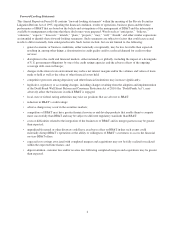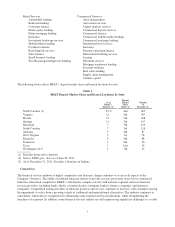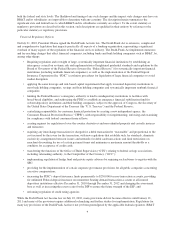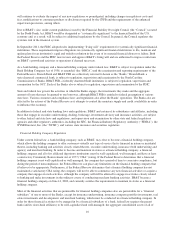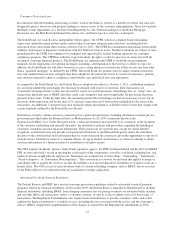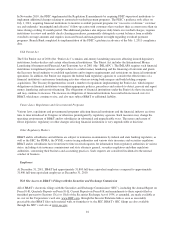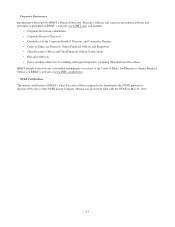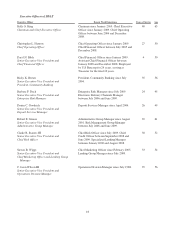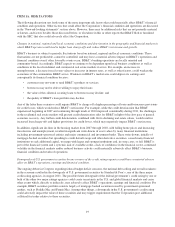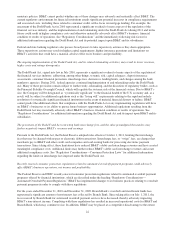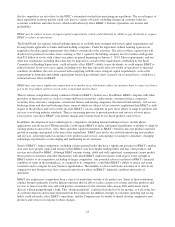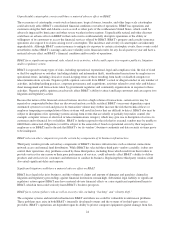BB&T 2011 Annual Report Download - page 14
Download and view the complete annual report
Please find page 14 of the 2011 BB&T annual report below. You can navigate through the pages in the report by either clicking on the pages listed below, or by using the keyword search tool below to find specific information within the annual report.
The ratios of Tier 1 capital and total capital to risk-weighted assets, and Tier 1 capital to adjusted average assets of BB&T,
Branch Bank and BB&T FSB as of December 31, 2011, are shown in the following table.
Table 2
Capital Adequacy Ratios of BB&T Corporation and Banks
December 31, 2011
Regulatory
Minimums
Regulatory
Minimums
to be Well-
Capitalized BB&T
Branch
Bank
BB&T
FSB
Risk-based capital ratios:
Tier 1 capital 4.0 % 6.0 % 12.5 % 13.4 % 18.9 %
Total risk-based capital 8.0 10.0 15.7 15.6 20.2
Tier 1 leverage capital ratio 3.0 5.0 9.0 9.5 18.6
The federal banking agencies, including the Federal Reserve, the FDIC and the OCC, are required to take “prompt
corrective action” in respect of depository institutions and their bank holding companies that do not meet minimum capital
requirements. The law establishes five capital categories for insured depository institutions for this purpose:
“well-capitalized,” “adequately capitalized,” “undercapitalized,” “significantly undercapitalized” and “critically
undercapitalized.” To be considered “well-capitalized” under these standards, an institution must maintain a total
risk-based capital ratio of 10% or greater; a Tier 1 risk-based capital ratio of 6% or greater; a leverage capital ratio of 5%
or greater; and must not be subject to any order or written directive to meet and maintain a specific capital level for any
capital measure.
BB&T, Branch Bank and BB&T FSB are all classified as “well-capitalized.” Federal law also requires the bank regulatory
agencies to implement systems for “prompt corrective action” for institutions that fail to meet minimum capital
requirements within the five capital categories, with progressively more severe restrictions on operations, management
and capital distributions according to the category in which an institution is placed. Failure to meet capital requirements
also may cause an institution to be directed to raise additional capital. Federal law also mandates that the agencies adopt
safety and soundness standards generally relating to operations and management, asset quality and executive
compensation, and authorizes administrative action against an institution that fails to meet such standards.
In addition to the “prompt corrective action” directives, failure to meet capital guidelines may subject a banking
organization to a variety of other enforcement remedies, including additional substantial restrictions on its operations and
activities, termination of deposit insurance by the FDIC and, under certain conditions, the appointment of a conservator or
receiver.
Deposit Insurance Assessments
The deposits of the Banks are insured by the DIF of the FDIC up to the limits set forth under applicable law. The FDIC
imposes a risk-based deposit premium assessment system, which was amended pursuant to the Federal Deposit Insurance
Reform Act of 2005 (the “Reform Act”) and further amended by the Dodd-Frank Act. Under this system, as amended, the
assessment rates for an insured depository institution vary according to the level of risk incurred in its activities. Effective
April 1, 2011, the FDIC implemented a revised assessment rate calculator, which is based on a number of elements to
measure the risk each institution poses to the DIF. The new assessment rate is applied to total average assets less tangible
equity, as defined under the Dodd-Frank Act. The assessment rate schedule can change from time to time, at the discretion
of the FDIC, subject to certain limits. On November 12, 2009, the FDIC adopted a rule requiring banks to prepay three
years’ worth of premiums to replenish the depleted insurance fund. The FDIC has published guidelines under the Reform
Act on the adjustment of assessment rates for certain institutions. Under the current system, premiums are assessed
quarterly. In addition, insured deposits have been required to pay a pro rata portion of the interest due on the obligations
issued by the Financing Corporation (“FICO”) to fund the closing and disposal of failed thrift institutions by the
Resolution Trust Corporation.
14


